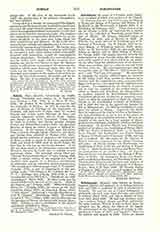

Schongauer, MARTIN (also known as Schon), German painter and engraver, b. at Colmar between 1445 and 1450; d. probably in 1491, it is believed at Breisach. He was the son of Caspar Schongauer, a goldsmith, who had come from Bavaria, and settled in Colmar about 1445, and who is known to have lived until about 1481. He had four brothers, Ludwig, a painter, Caspar, Georg, and Paul, goldsmiths. By some authors, Martin is said to have been the youngest son, by others, the eldest of the family. He matriculated at the University of Leipzig in 1465, purchased a house in 1477, and founded a Mass for his parents and himself in 1488. These are almost the only facts we know concerning him, and all other information about him is derived from dates on his drawings or engravings. His masterpiece is known as the “Virgin in the Garden of Roses”, and is in the Church of St. Martin at Colmar. He has been described as a pupil of Rogier van der Weyden, on the authority of a letter written to Vasari, but although Rogier vander Weyden’s influence is to be recognized in Schongauer’s work, it seems very doubtful whether he ever entered that painter’s studio. Several of his paintings are dated, but with the exception of the one in Colmar, we have no absolute evidence that any one of them is his work, and no documents have yet been discovered enabling us to verify his paintings. We are very much in the same position with regard to his engravings. They bear the signature of his initials, but there is nothing in the statements of his contemporaries to say with absolute certainty that the engravings signed M. S. are his work. There is, however, very little doubt in the matter, and they are always accepted as being his work. He is not to be regarded as a great artist or a perfect draughtsman, but in the actual technic of line engraving he is unsurpassed in his period, and is practically the equal of Durer. About a hundred plates attributed to him are in existence, and there is an almost perfect collection of his prints in Berlin, a collection almost equal to it existing in London.
GEORGE CHARLES WILLIAMSON

